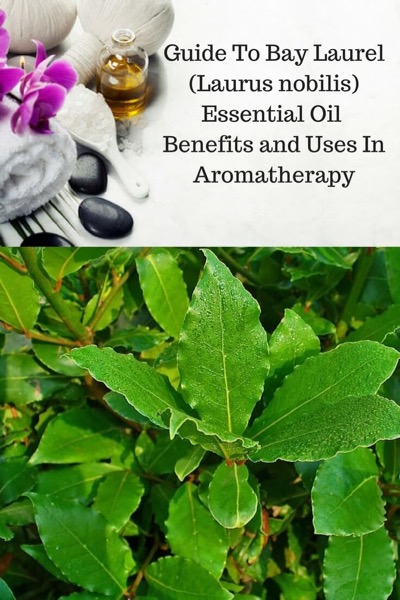- Home
- Essential Oil Profiles
- Bay Laurel Essential Oil
As an affiliate for Bookshop, Amazon, and other programs, I may earn a small commission for products purchased through links. This doesn't affect the price you pay. Privacy policy and disclosures.
Search this site:
Guide to Bay Laurel Essential Oil Benefits and Uses
"[Bay laurel essential oil] is the fragrance of victors and poets, who have each used imagination and inspiration to attain their goals," according to aromatherapist Valerie Ann Worwood in Aromatherapy For the Soul. She also writes the emotional benefits of bay laurel (Laurus nobilis) are to support confidence, inspiration, creativity, and direction.

Basic Bay Laurel Facts
Plant family: Lauraceae
Production: Steam distilled from the leaves and branches of the bay laurel, which is an evergreen shrub or small tree. A small amount of essential oil can be distilled from the berries, but a berry oil is more likely to be a pressed fruit oil than an essential oil.
Aroma: Spicy, sweet, fresh, balsamic.
Perfume/Aromatic note: Top to middle
Is bay laurel safe to use during pregnancy? No, according to The Complete Book of Essential Oils and Aromatherapy.
Is bay laurel safe for children? Do not use with children under age 2, according to Essential Oil Safety.
Cautions: May irritate sensitive skin. Frequent use on skin may cause sensitization. Too much of the fragrance may cause headaches.
Do not confuse bay laurel essential oil (Laurus nobilis) with West Indian bay (also called bay rum) essential oil (Pimental racemosa). Though they have some broad aromatic similarities, they are different oils.
Main components:
- 1,8-cineole 38.1–43.5%
- alpha-pinene 7.1–15.9%
- alpha-terpinyl acetate 4.5–7.0%
- linalool 6.2–6.5%
Source: Essential Oil Safety, 2nd Ed.
Bay Laurel Aromatherapy Benefits
Aromatherapy: A Complete Guide to the Healing Art: The scent is stimulating, improves memory, relieves headaches and stress, and may stimulate digestion.
Essential Oils & Aromatherapy for Dummies: Bay laurel is a warming essential oil that can help relieve muscle tension. Use the essential oil in a massage oil to stimulate lymph and blood circulation. The scent may help improve memory, relieve headaches, reduce sinus and lung congestion, and support the immune system.
The Encyclopedia of Essential Oils (updated edition): Bay laurel oil is useful to help relieve indigestion, flatulence, loss of appetite, scanty periods, colds, and flu.
Essential Oils: All Natural Remedies: Use bay laurel to sooth aches and pains, for colds and flu, and for sleep. The oil is associated with peace, wisdom, and inner confidence.
The Complete Aromatherapy and Essential Oils Handbook for Everyday Wellness: This oil helps the digestive system and is tonic for the liver and gallbladder. Used in a massage oil blend, bay laurel can help relieve lymph congestion.
Aromatherapy For Healing the Spirit: In Traditional Chinese Medicine the primary energetic actions of bay laurel are to circulate and regulate Qi and to clear cold phlegm. The essential oil is indicated for chilly, congested people who lack energy and self confidence.
Aromatica: A Clinical Guide to Essential Oil Therapeutics, Volume 2: Psychologically, laurel promotes emotional renewal, clarity, willpower, courage, and self-confidence. Physically, the essential oil restores hypotonic/weak conditions and relaxes hypertonic/tense conditions. In Traditional Chinese Medicine the essential function of the oil is to tonify the Q, activate Qi and Blood, and strengthen the Shen.
Ayurveda and Aromatherapy: The rasa (taste) of bay laurel is pungent, bitter, astringent; the vipaka (aftertaste) is pungent; and the virya (energy) is heating and drying. The oil balances vata and kapha and increases pitta. Tissues most affected by the oil are hair, nails, stomach, and small intestine. Indications for this essential oil include respiratory problems, muscle and nerve pain, and scalp dryness.
Aromatherapy and Subtle Energy Techniques: Bay laurel clears and cleanses the energy centers. The oil is especially useful for the sixth chakra, clearing mental blocks and outmoded ways of thinking and supporting intuition.
Mixing Essential Oils for Magic: Bay laurel aids in prophetic dreaming, divination, and clairvoyance; increases psychic powers and offers protection during their use; and clears negative energy from the home. The oil is also associated with awareness, inspiration, and intuition.
Bay Laurel Essential Oil Uses and Blends
To make a massage oil, add 5 drops bay laurel essential oil to 2 teaspoons carrier oil. You can use the massage oil for sore muscles or on your abdomen for digestive problems.
Sore-Muscle Relief Massage Oil
- 4 drops bay laurel
- 4 drops eucalyptus essential oil
- 4 drops rosemary essential oil
- 3 drops ylang ylang essential oil
- 1 tablespoon carrier oil
Massage Blend for Sleep
- 3 drops bay laurel
- 4 drops lemongrass essential oil
- 4 drops lavender essential oil
- 4 drops petitgrain essential oil
- 1 tablespoon carrier oil
At bedtime, massage the blend into your upper chest, back of the neck, shoulders, and areas of your back you can reach.
Source: AromaSense
To help relieve congestion from cold or flu, use bay laurel in a diffuser blend or in a steam inhalation. For swollen lymph glands, Advanced Aromatherapy: The Science of Essential Oil Therapy recommends rubbing a few drops of the essential oil over the glands.
Make a cleansing, uplifting room spray:
- 9 drops bay laurel essential oil
- 4 drops rosemary essential oil
- 1/2 cup distilled water
Blend ingredients in a spray bottle. Shake well before each use.
Make a body scrub that supports the lymphatic system:
- 1 cup fine sea salt
- 1/2 cup jojoba oil
- 12 drops bay laurel
- 7 drops grapefruit essential oil
Blend all ingredients in a glass jar. Use as desired for a body scrub.
Source: Floracopeia
Make a forming soap:
- 4 tablespoons liquid castile soap
- 15 drops Laurus nobilis essential oil
- 10 drops orange essential oil
- 5 drops lavender essential oil
Blend all ingredients in a 2-ounce (60 ml) foam pump bottle.
Source: Aromahead
Buy essential oils from Aromatics International (recommended).
Rocky Mountain Essential Oils.
Photo Credit: Bay leaves by H. Zell [CC BY-SA 3.0], from Wikimedia Commons



